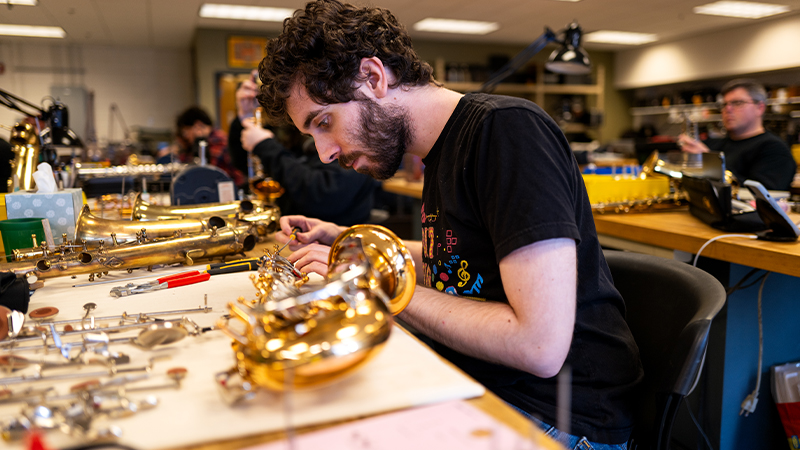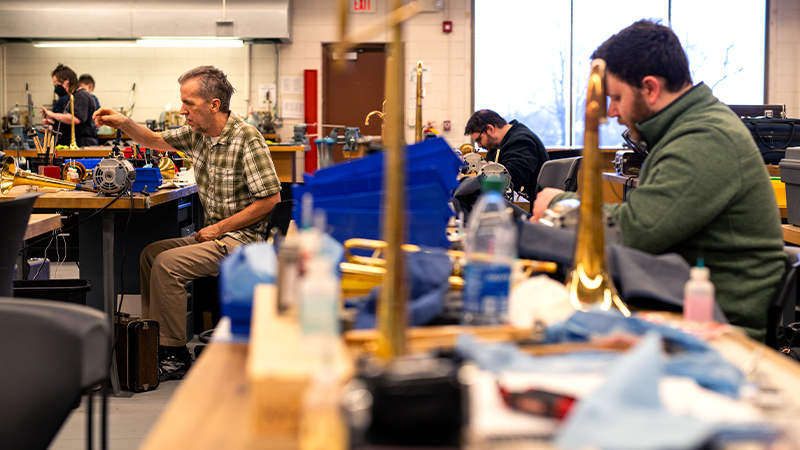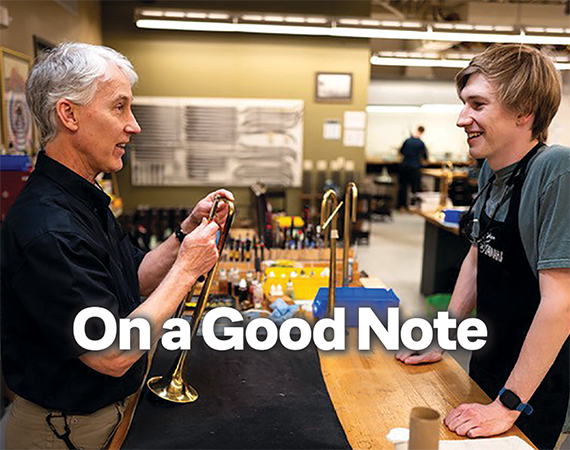When school is in session at Minnesota State College Southeast (known as Southeast) in Red Wing, the common areas are filled with music, and you never know which instruments will be joining — students start jam sessions that might include trombones and guitars, violins, and clarinets.
The lively tunes fill the hallways and offices, but this isn’t a performing arts school. Instead, the students are proving they’re learning a craft that will help performers around the country and perhaps even throughout the world: music instrument repair, a highly specialized skill that’s taught in only a few colleges.
“There are very few programs that do what we do,” says John Huth, an instructor for band instrument repair. “There’s a reason our students come from all over. We’ve established a reputation because we love what we do here, and we’re excited to keep that going well into the future.”

Tuning up
The Southeast program is composed of three tracks: band instrument repair, guitar repair and building, and violin repair and making. Originally, however, it was just one program for guitar and violin combined, launched in 1974 when the school was under its previous name, the Red Wing Area Vocational-Technical Institute. Band instruments were added to the curriculum two years later; demand became so pronounced that violin was split off from guitar repair as its own program. This also allowed for deeper dives into the intricacies of repairing each family — guitar and violin — and permitted growth within each discipline.
At the time of its founding, the college’s director, Ed Dunn, wanted to develop a program that wasn’t offered at any other place in the Upper Midwest. That came as part of a mandate from the state of Minnesota, which was insistent that programs within vo-tech not compete with other offerings in the system.
“Basically, they didn’t want to flood the market with all these options, because there would only be so many students and that would be challenging for the schools,” says Dr. Marsha Danielson, Southeast president. The technical school offered traditional programs like nursing, fashion design, secretarial skills, auto repair, welding, and others — Southeast still maintains some of these, like welding and nursing — but needed unique programming that wasn’t offered anywhere else.
Some initial attempts didn’t pan out. The school created a program for repairing electronic music instruments, since those were just taking off in the late 1970s, but the field seemed to be too new to support a full program. Then, the college tried accordion repair, but that’s such a niche instrument that there was concern demand for repair would dwindle. However, the guitar and violin program was popular from the start, and when band instruments were added and the program was split into three, that popularity remained.
Even after 52 years, that’s still true. There’s a band instrument repair program in Iowa and another in Seattle but even with those, Southeast is the largest, Huth says. That’s one reason classes are consistently full every session — capacity is 24 for guitar, 48 for band instruments, and 20 for violin. For example, if a student wants to sign up for fall 2025 for band instrument repair, a pop-up message appears on the website noting that there’s a waitlist.
Although the school does some outreach to band directors — the ones most likely to refer students to one of the programs — that type of marketing doesn’t need to be particularly aggressive, since most people in the industry are aware of Southeast programs, thanks to its many graduates and the stature of its instructors. For example, at a national conference on musical instrument repair and manufacturing, there’s always a Southeast instructor as a key speaker.

For Greg Beckwith, a band instrument repair instructor, the history is personal: It was his father, Gene, who started that particular repair program, with 18 students. He jokes that coming to Southeast was a natural transition, since their house was usually filled with instruments in various states of repair. Seeing worktables filled with tools and parts feels like home — and even though the students haven’t grown up in that way, he often hears that they feel the same emotions of coming home when they step into the workrooms.
In terms of student mix, the three programs typically don’t attract only recent high school graduates; instead, there’s a breadth of ages and experience. For example, some students are retirees who enroll as a way to have a meaningful post-retirement hobby. Others are making a career pivot, from office jobs where they once used their hands only for computer use, to selecting repair tools the way a surgeon would select just the right scalpel.
Over the past 50 years, students have come from all 50 states as well as several foreign countries, including Canada, the UK, Oman, Botswana, Thailand, Korea, Australia, and Switzerland, among others.
No matter what their origin or previous career path, being at one of the workstations in the warren of repair rooms brings out a kind of enthusiasm and passion students may not have had before.
“Like the other instructors, I love my job because you really see the students blossom while they’re here,” says Tim Reede, an instructor for the guitar repair and building program. “We have a breadth of ages and backgrounds, but they really do form a tight bond with each other through a shared appreciation for music and a desire to help musicians be able to continue to play.”
That sentiment can get even more pronounced in a second-year program that enables students to make their own guitars, ending with a showcase of their work that highlights their creativity, Reede says. For instance, some choose to make less-common instruments like a mandolin. It’s particularly exciting during the showcase to have professional musicians play what they’ve created, he adds. That’s just one more way that the students — all of them musicians themselves to varying degrees — are able to feel more connected to the instruments, the musicians, and the school.
Playing well together
The demand for instrument repair is steady; the college notes that the employment rate for violin repair is 100%, band instrument repair is 96%, and guitar repair is 78%.
Most graduates from the band instrument repair program move out of state, but three of them stayed to open Red Wing Music, a small storefront tucked into the old main street near the river. Run by Zoe Preuss, Jason Bystrom, and Rob Schmidtke, the shop is a jumble of parts and instruments in the process of repair, with a painting of a broken flute that Preuss painted in high school — signaling her early interest in what would become her profession. The three owners all graduated in different years, but they share a love for the school and its instructors to the point that Preuss and Bystrom serve on a school advisory committee and act as substitute instructors when needed.
While they appreciated the depth and breadth of their repair education, what they praise most is the program’s sense of community, and the excitement the instructors bring to class every day.
“There’s just a kind of zany, lively energy that’s occasionally chaotic, since you have people playing and working with the instruments all the time,” Bystrom says. “That’s coupled with these instructors who are so committed to their students and to the work. Right from day one, you feel like you’re part of something greater, and that is so valuable.”
Bystrom is from the Red Wing area originally, and realized he wanted to do instrument repair when he was still in high school playing in the brass section of the marching band. A clarinet player agonized over a missing part just before they went on the field, and he ended up fixing the problem with a paper clip — a remedy that “wouldn’t be part of the curriculum at Southeast,” he jokes.
“It was really cool to be able to fix something in a way that let that musician get back to playing,” Bystrom recalls. “Originally, I’d wanted to be a band director, but that experience changed my path, and I’m happy about that because I didn’t realize how creative instrument repair could be. I also get to work with my hands, which is something I didn’t know I loved until I was doing it.”

For Preuss, who’s from Wisconsin, the pivot moment came after she helped her family in a house remodel, and she found she enjoyed using tools and doing repair. She also loved art and realized while talking with a band teacher that she could combine both interests with instrument repair, since there is definitely an artistic element to the way instruments are made and fixed.
“What I loved was the community aspect at Southeast, in part because we were all band geeks,” Preuss says. “Plus, the instructors are so respectful. They talk to students like they’re competent from the very start. We love being involved because you can see the program evolving thanks to the technology they’re bringing in, and that’s advancing the field.”
Part of the community vibe comes from a shared mission, Beckwith adds. While the main focus is to take an instrument that’s not working well and allow it to play properly again, there’s an underlying drive, too — the students don’t just fix the instruments, they also support the musicians who will use them.
“There’s really something special about working with musical instruments compared to other types of objects,” Beckwith says. “You’re aware that at the other end of this violin or guitar or saxophone, there might be a child who’s just started to play and who’s excited to improve. Or you may have a professional musician at the height of his or her art, who has an incredible bond with this instrument. We get to instill that passion for helping others into our students, and we can see that in their work.”
Focusing on the future
Although part of the program’s strength is in its reputation and foundational instruction, there’s also a significant element of innovation, as Preuss notes. In the warren of rooms at Southeast, alongside traditional hand tools that allow for gentle violin sanding or repairing a guitar neck, there’s a CAD system, a computer-aided design program that can digitally create 2D drawings and 3D models. There’s also a CNC (computer numerical control) system, used for machining parts, as well as computer-controlled routers and laser cutters.
Particularly with 3D CAD, combined with a 3D printer — which is also available and Huth has been using for creating different instrument tools — it’s possible to modify designs easily, and to do some repairs on older instruments that might have been impossible otherwise. For example, although the Southeast program doesn’t teach instrument making in its first year, being able to put a certain instrument together is fundamental to repair, and sometimes the parts are no longer available. The 3D printer can solve that problem by creating the molds, fixtures, and other tooling to help make a part that would be impossible otherwise.
There are still many aspects of instrument repair that rely on careful, time-consuming, hand crafting — especially with a delicate instrument like a violin — but integrating tech into the program helps students become more efficient with their time, and it gives them more skills to bring into a future workplace, says Huth. For example, some students go on to work at guitar manufacturing companies, which use CAD systems frequently.
“Being able to combine working with your hands along with these technologies is a crucial skillset, and it’s a major part of why this program is well known nationally,” says Adam Potthast, Southeast’s dean of liberal arts, sciences, and transfer.
The way the CAD systems and other technology are situated in the instruction rooms next to guitars, violins, and band instruments is a good metaphor for the overall feel of the program: Southeast creates a blend of tradition and innovation that helps students carry on the tradition of repair, while prepping them for the future of the instrument industry. Along the way, the program gives them a sense of camaraderie that lasts long after they’re no longer playing in the common areas of the Red Wing campus.
“Musical instruments and musicians are timeless; they’ll never be replaced by machines because there’s such artistry and craft involved,” Reede says. “Instrument repair is the same; there’s a craftsmanship that is aided by technology but not overwhelmed by it. This can’t be automated, and the longer you do this work, the better you get at it. That’s what we’re teaching — a skill that deepens with time and that connects you to a community.”
Return to the Fall 2025 issue of Enterprise Minnesota® magazine.


